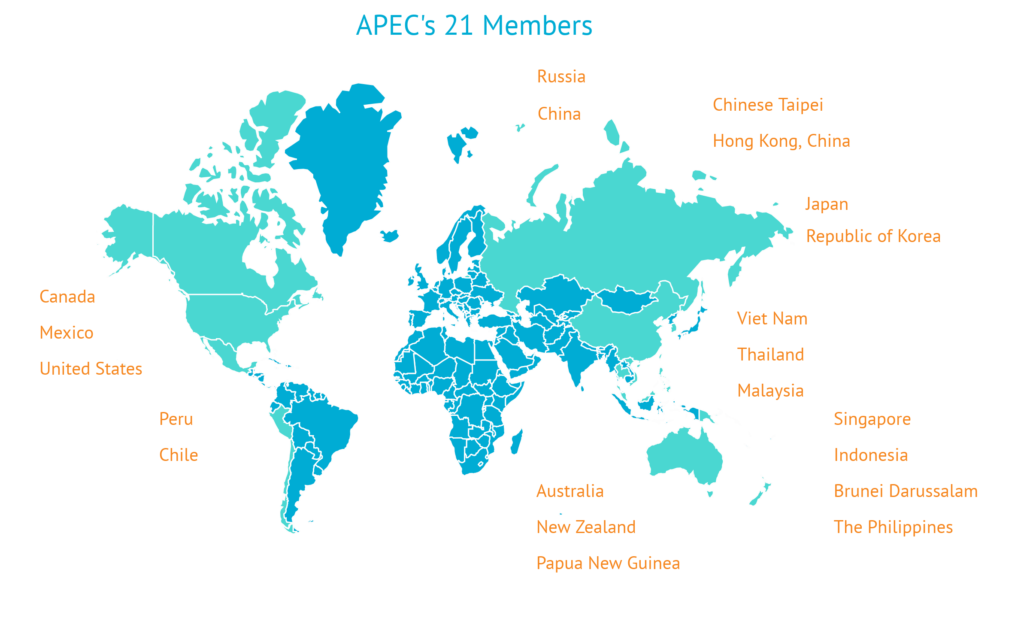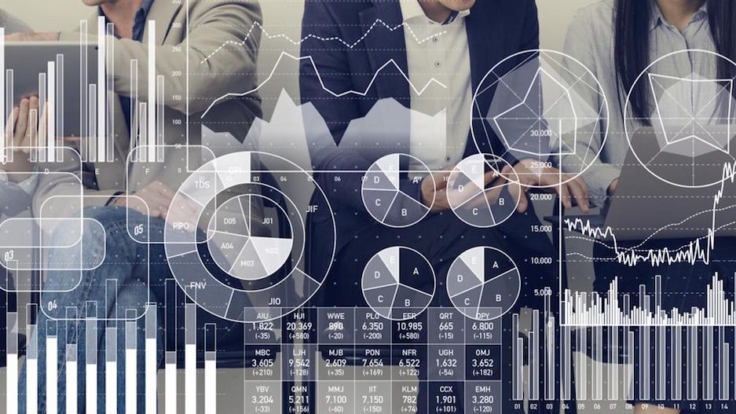Published 06 June 2019
The Asia-Pacific Economic Cooperation (APEC) is an incubator of trade policy ideas and a pragmatic driver of initiatives in emerging areas of trade that matter not only to the Asia-Pacific region, but also globally.
Menu of options to grow trade
Countries utilize multiple platforms to open markets, set standards or other rules of trade, and resolve disputes. Progress in reducing barriers to trade and facilitating the flows of goods and services may be an outcome of negotiated free trade agreements between two or more countries or result from legally binding instruments agreed to in multilateral fora like the World Trade Organization (WTO).
In contrast, decisions in the Asia-Pacific Economic Cooperation (APEC) forum, a grouping of 21 economies that border the Pacific Ocean, are reached by consensus but undertaken on a voluntary basis. This format is credited with enabling members to “incubate” content for new trade negotiations and to work collaboratively on pragmatic regulatory and policy approaches to common challenges.
The APEC forum culminates each fall in a meeting of the 21 leaders, a gathering many associate with the annual “silly shirts” photo of top officials genially wearing the national garb of the host economy, rather than their typical business suit. However, the work of APEC goes on for many months before this fashion summitry takes center stage to solidify each member’s commitments.
This article introduces this cooperative, regional forum; highlights the priority focus areas set out by this year’s APEC host, Chile; and shines a spotlight on one such area – digital trade – as a case study into how APEC serves as a building block in the iterative process of co-creating norms for trade.
Spotlight on APEC
The 21 members of APEC, which includes economies as diverse as the United States and Papua New Guinea (last year’s APEC host), are home to almost three billion people and represent close to half of world trade.
When the organization formed in 1989, APEC had Australia, Brunei Darussalam, Canada, Indonesia, Japan, Korea, Malaysia, New Zealand, the Philippines, Singapore, Thailand and the United States as founding members. China; Hong Kong, China; and Chinese Taipei joined in 1991. Mexico and Papua New Guinea acceded in 1993, and Chile joined in 1994. In 1998, the addition of Peru, Russia, and Vietnam brought the organization to its current membership level.

Every year one of the 21 APEC member economies serves as the APEC Chair. Over the course of a year and typically in multiple cities, the Chair hosts a series of senior officials’ meetings, ministerial meetings, and a Leaders meeting. Ministerial meetings include gatherings of Trade and Foreign Ministers from each of the economies, as well as sectoral ministers overseeing other key areas, including energy, finance, and education. The host economy also welcomes the APEC Business Advisory Council (ABAC), up to three senior business leaders per economy, appointed by their governments, who provide private sector input into the APEC process.
Between 1989-1992, APEC dialogues were held at the senior official and minister level. In 1993, former US President Bill Clinton began the practice of an annual leader meeting when he hosted an APEC meeting in Seattle. The following year, APEC leaders made a commitment to jointly work toward free and open trade in the Asia-Pacific by 2020. This commitment is known as the Bogor Goals for the Indonesian city where APEC leaders met in 1994.
A defining feature of APEC is that members voluntarily take actions to reduce barriers to trade and investment without a requirement to make legally binding obligations. Beyond a core focus on trade and investment liberalization, APEC also promotes business facilitation, with the goal of taking time, cost, and uncertainty out of doing business across the region, as well as technical cooperation, to boost the technical capacity of APEC’s less developed members to drive secure and sustainable economic growth.
From idea to fruition
Notable accomplishments within APEC include its work on environmental goods, where members have undertaken tariff reductions on a list of 54 environmentally friendly goods. This tariff-cutting effort laid the groundwork for ongoing negotiations at the WTO on an Environmental Goods Agreement with expanded product coverage.
Another key APEC deliverable has been the APEC Privacy Framework, which established principles and implementation guidelines for privacy protection, and which underpins the APEC Cross-Border Privacy Rules (CBPR) system. Currently, eight APEC members—Australia, Canada, Chinese Taipei, Japan, Korea, Mexico, Singapore and the United States—participate in the CBPR system.
APEC also delighted many travelers on the APEC circuit with the creation of the APEC Business Travel Card, which allows cardholders visa-free access to APEC economies for up to 90 days and special APEC fast lanes in the major airports of APEC members. According to the 2018 report of the APEC Committee on Trade and Investment to Ministers, as of the end of June 2018, over 278,000 cards had been issued.
Onward to Santiago
Like a Chilean fine wine, the business travel card is something nice to have in hand given the over 200 working group meetings, workshops, ministerial, academic, and business meetings taking place over Chile’s APEC year. Chile’s host year will culminate in the summit of the 21 APEC leaders in November in Santiago. As the host economy, Chile has identified four priority areas on which it seeks concrete deliverables:
Digital Society, an initiative encompassing efforts to develop cross-border digital trade standards and make needed changes to education and labor systems;
Integration 4.0, which seeks to tackle some of the newer sources of trade frictions and enhance connectivity through customs coordination and border automation;
Women, Small and Medium Enterprises and Inclusive Growth, an agenda designed to increase women’s participation in the economy and to enhance the ability of small and medium-sized business to realize the benefits of trade in the region, including in the area of digital trade; and
Sustainable Growth, which includes initiatives to protect the marine ecosystem and promote cooperation on both energy and smart cities.
Division of labor on digital trade rules
Chile’s focus on the digital economy reflects the priority that APEC leaders have increasingly placed on promoting sound policies to govern digital trade in the Asia-Pacific region. The spotlight on digital policy is also a good case study in the iterative way global trade norms are shaped and how an organization like APEC both influences and is influenced by parallel policymaking efforts.
APEC prides itself on its role as an incubator of ideas and driver of initiatives in emerging areas of trade that matter not only to the Asia-Pacific region, but also globally.
Dating back to its 1998 APEC Blueprint for Action on Electronic Commerce, which defined principles for the development of e-commerce in the region, APEC members have recognized that without a framework to govern the surge in digitally enabled trade, the full potential of digital technologies may not be realized. They also understood the challenges associated with designing regulatory frameworks that encourage growth while protecting privacy and security, particularly given differing domestic regulatory approaches on key issues like treatment of data. In its work on the various building blocks for digital trade – from cross-border privacy rules to trade facilitation and services liberalization – APEC has engaged multiple outside organizations, including the International Chamber of Commerce, the Organization for Economic Cooperation and Development (OECD), and the United Nations Centre for Trade Facilitation and Electronic Business (UN/CEFAT), facilitating mutually beneficial idea exchange.
In 2016, 12 APEC economies signed the Trans-Pacific Partnership Agreement or TPP (the United States later withdrew). The TPP’s e-commerce chapter covered a range of traditional and emerging issues, including customs duties, electronic authorization and signatures, cross-border data flows, source code, cybersecurity, and privacy protections. Initiatives like the APEC Privacy Framework inspired certain TPP provisions but, unlike the APEC framework, what is now known as the Comprehensive and Progressive Agreement on Trans-Pacific Partnership (CPTPP) is a binding agreement with enforcement provisions. The reforms required by the agreement, including prohibitions on data localization and protections for the movement of data, will set a new bar as CPTPP potentially expands to new members and as new trade agreements are forged.
For example, in mid-May, on the sidelines of this year’s APEC meeting of Ministers Responsible for Trade, Chile’s Minister of Foreign Affairs, Singapore’s Minister of Trade and Industry, and New Zealand’s Minister for Trade and Export Growth announced the start of negotiations towards a Digital Economy Partnership Agreement. The officials announced an intent to build on the CPTPP e-commerce chapter, but also look at emerging areas like digital identity and artificial intelligence. Any agreement reached between Chile, New Zealand and Singapore will be open for accession by other WTO members who can meet the high-quality standards to be established in the agreement.
Underscoring the iterative nature of trade policy building, the three APEC and CPTPP members indicated that their work would build on the work underway within APEC, the OECD, and other international forums; generate ideas for use by countries negotiating free trade agreements; and complement current WTO negotiations on e-commerce. In the latter talks, 76 WTO members (including all APEC members except Indonesia, Philippines, Papua New Guinea, and Vietnam) are working to create multilateral rules governing electronic transactions.

Culture and consensus
APEC members leverage their APEC host year to drive progress on their national trade priorities in the spirit of collaboration and consensus. The various APEC meetings throughout the year also provide an opportunity to showcase the member’s unique achievements before large audiences of distinguished visitors, while also showing off the cities where the meetings take place. This year, for example, Chile will welcome more than 15,000 representatives of member economies, APEC observers, business leaders, and international press in Viña del Mar, Puerto Varas, and Santiago.
Shining a spotlight on the unique cultural offerings of a host economy – such as the Royal Barge Procession for APEC leaders on the Chao Phraya River in Bangkok in 2003 or China’s grand 2014 APEC welcome ceremony with light shows, singing, and dancing – is also a time-honored tradition. Unfortunately, the infamous “silly-shirted” photos tradition may be wavering. The last time the United States hosted APEC in 2011 in Hawaii, President Obama found APEC-like consensus agreement to nix the collective donning of aloha shirts and grass skirts, quipping, “I didn’t hear a lot of complaints about us breaking precedent on that one. I thought this may be a tradition that we might want to break.”
© The Hinrich Foundation. See our website Terms and conditions for our copyright and reprint policy. All statements of fact and the views, conclusions and recommendations expressed in this publication are the sole responsibility of the author(s).




